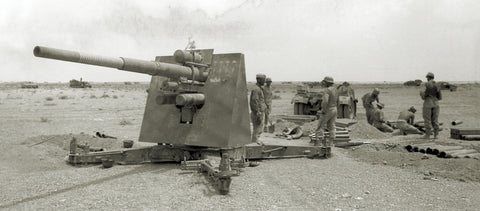
For Allied Planes and Tanks, Germany’s 88mm Flak Gun Doubled the Trouble
It wasn't long after the advent of flying war machines before militaries developed weapons to shoot them down. Germany experimented with anti-aircraft guns in World War I and, despite post-Versailles restrictions that ostensibly limited German war industry, in the 1930s they designed the Flak 18, an accurate, high-muzzle-velocity, 88mm anti-aircraft gun. It proved its worth during the Spanish Civil War and became one of the best known and most feared weapons of World War II.
As an anti-aircraft weapon the Flak was lethally effective. The gun’s high velocity and rapid firing rate allowed synchronized German batteries of four to accurately hurl massive 17-pound shells thousands of feet into the air, where they would explode into 1,500 fragments or more, leaving tell-tale black puffs of smoke. Any aircraft within 200 yards were at risk from the scything shards of metal. Tens of thousands of Allied airplanes fell victim to 88mm Flaks during the course of the war.
While the Wehrmacht initially thought the gun too large and heavy to serve in the field, its effectiveness in Spain made them revise their tactics. The improved Flak 36, introduced in 1939, had the flexibility to shoot at low angles, and its variety of both high-explosive and armor-piercing shells were effective against Allied tanks and fortified positions from more than 1.5 miles. The gun was eventually adapted for use on tanks, but the Germans deployed the majority of the Flaks in its original anti-aircraft role for home defense.
